The Specter of Communism Captivates the Nation
On a domestic level most Oregonians and other Americans enjoyed peace and prosperity in the late 1940s and 1950s. But on another level they nursed Cold War fears as the Soviet Union and Communist China advanced their agendas on the world stage. Meanwhile, at home they wondered if communist spies were around every corner plotting the destruction of American institutions from within. They heard Wisconsin Senator Joseph McCarthy make shocking charges against important government officials and they watched as some of Hollywood's stars, such as Orson Welles and Edward G. Robinson, were blacklisted for alleged ties with communist organizations. They saw teachers, professors, and others scrutinized and forced to sign loyalty oaths. And they wondered: Were their children's teachers communists? Was their coworker a communist? ...or their neighbor? These questions, and fears of an atomic war, crept into the minds of many Oregonians during a prosperous but unsettling period.
The Global Cold War
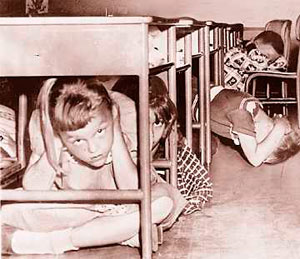 Students practice ducking and covering during a classroom drill. The efforts were intended to protect the children in the event of an atomic attack. (Image courtesy detnews.com)
Students practice ducking and covering during a classroom drill. The efforts were intended to protect the children in the event of an atomic attack. (Image courtesy detnews.com) The phenomenon that came to be known as the Cold War was destined to become the defining geopolitical, ideological, and economic struggle of the last half of the 20th Century. The global contest took its name because direct hostilities never occurred between the two main opponents, the United States and the Soviet Union. On the heels of World War II, the Soviet Union successfully engineered the creation of communist regimes in several eastern European nations such as Poland, Hungary, East Germany and Czechoslovakia. These buffer states formed part of the Eastern Bloc and were divided from western Europe by what Winston Churchill called the "iron curtain," in reference to the brutal and repressive communist regimes. (
 Listen to a 1946 Winston Churchill speech about the iron curtain
Listen to a 1946 Winston Churchill speech about the iron curtain - via YouTube)
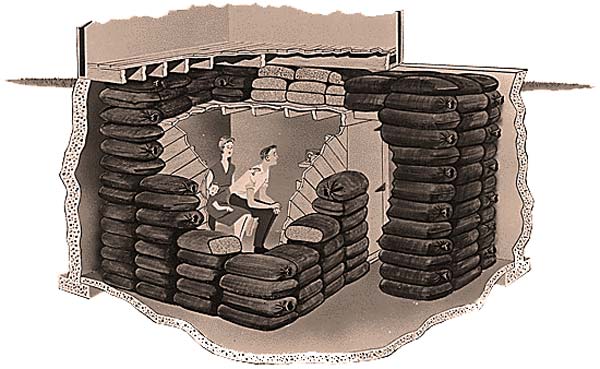 This 1957 drawing shows a basement fallout shelter. Many Americans built basement or backyard shelters, hoping to survive an atomic attack.
Artist's rendition courtesy National Archives
This 1957 drawing shows a basement fallout shelter. Many Americans built basement or backyard shelters, hoping to survive an atomic attack.
Artist's rendition courtesy National Archives Meanwhile, U.S. Secretary of State George Marshall oversaw a massive infusion of economic aid to western European nations, both to bolster these countries as American trading partners and ward off the effectiveness of leftist political movements. In 1949 the United States joined 10 western European countries and Canada to form the North Atlantic Treaty Alliance (NATO) for collective security. The alliance would consider an attack on one member to be an attack against all. The stage was set for decades of standoff in Europe. With the Soviet Union successfully detonating an atomic weapon in 1949, a generation of brinksmanship became governed by the concept of mutually assured destruction (MAD). The idea was that neither side would attack the other because, considering the destructive power of the atomic weapons, to do so would be suicidal. To reinforce the concept, both sides engaged in an expensive arms race, each developing more powerful bombs and more effective delivery systems.
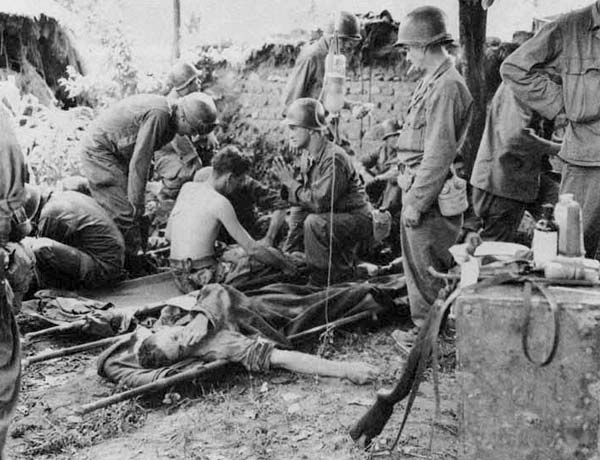 Medics treat wounded soldiers during the Korean War. United Nations forces fought North Korean and Chinese communist forces to a stalemate.
Image courtesy Truman Presidential Museum and Library
Medics treat wounded soldiers during the Korean War. United Nations forces fought North Korean and Chinese communist forces to a stalemate.
Image courtesy Truman Presidential Museum and Library With the stalemate in Europe, the Cold War moved to lower level struggles around the world. As the Soviet Union projected its influence and ideology globally, the United States and its allies worked to check its moves. But communist influence was on the rise in the late 1940s and the success of communist forces in taking control of China in 1949 alarmed America and its allies. When war broke out in 1950 on the Korean Peninsula between communist and western aligned forces, the United States and 15 other United Nations members entered the conflict in an attempt to roll back communist aggression. Over the next three years, UN forces battled Soviet supported North Korean troops, and later Chinese forces, but could achieve nothing more than a stalemate. At the same time, Soviet and American intelligence operatives fought a behind the scenes war in countries such as Iran and Guatemala in the mid-1950s, building and toppling governments in the process. Meanwhile, in the 1950s and beyond, communist operatives followed a pattern of influencing and co-opting forces fighting for independence from colonial control in such places as Vietnam. These efforts, along with western attempts at influence led to the so-called proxy wars that became an important part of the global Cold War.
Naming Names in Hollywood
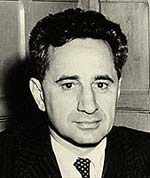 Film director Elia Kazan chose to "name names" in the hunt for communists in America. Others in the film industry refused to cooperate and were blacklisted. (Image courtesy dga.org)
Film director Elia Kazan chose to "name names" in the hunt for communists in America. Others in the film industry refused to cooperate and were blacklisted. (Image courtesy dga.org) The brutal and insidious methods used by Soviet operatives to crush democratic parties and governments in eastern Europe in the wake of World War II were not lost on American observers. Many could imagine that the very same tactics were being used by communists in the United States. Political pressure grew in the late 1940s to find communist spies and those spreading communist ideology. Opportunistic politicians on the Congressional House Committee on Un-American Activities (HUAC) quickly found high profile targets in Hollywood, reasoning that communists were using popular films to influence Americans. Certainly, many people in the motion-picture and other creative and intellectual professions had flirted with communist ideology during the desperate economic times of the Depression. Others had friends or relatives who were Communist Party members. During hearings beginning in 1947, actors, directors, screenwriters and others were called to expose and testify against their colleagues. Some, such as director Elia Kazan, chose to "name names," saying it was patriotic to do so. Others went along because of fear of the consequences if they didn't. Many refused to cooperate on a number of civil rights grounds, leading to two fates. One group, dubbed the "Hollywood Ten," was convicted on contempt charges, its members eventually spending up to a year in prison. Those convicted were also blacklisted, or frozen out of employment for over a decade. Another group of more than 300 people employed in films and related industries was blacklisted during the worst of the so-called "Red Scare."
Loyalty Investigations and Oaths
At the same time the federal government adopted the use of loyalty oaths to purge employees with communist connections and enforce conformity. Bowing to political pressure to hunt down "subversives" in the federal government, President Truman signed Executive Order 9835 in 1947 establishing the Federal Employee Loyalty Program. The program directed the FBI to look for "reasonable doubt" of loyalty. Loyalty boards were created to review the field investigations into questionable people. Those accused were not allowed to confront their confidential accusers and no appeals were allowed. From 1948 to 1958, over 4.5 million employee names were checked, resulting in 27,000 field investigations. While 5,000 people voluntarily resigned (many no doubt from the stress alone), only 378 employees were dismissed or denied employment. None of these were proven to be spies.
Footnote 1
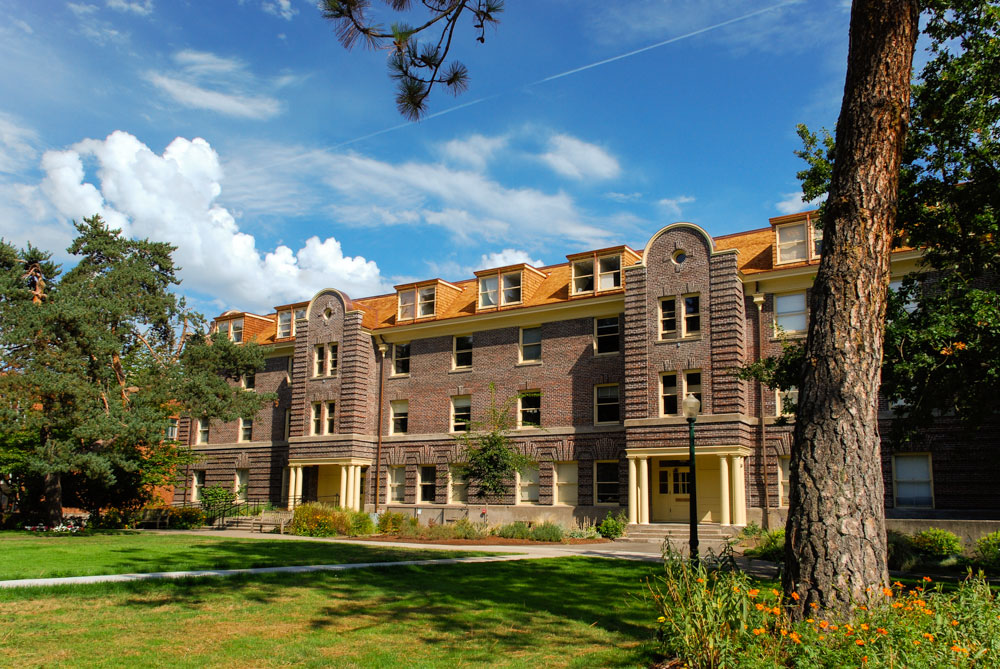 State college and university professors feared the Oregon Legislature would follow neighboring states that went on witch hunts against professors accused of being communists. Shown above is Friendly Hall on the University of Oregon campus. (Oregon State Archives Scenic Image 20090913-2011)
State college and university professors feared the Oregon Legislature would follow neighboring states that went on witch hunts against professors accused of being communists. Shown above is Friendly Hall on the University of Oregon campus. (Oregon State Archives Scenic Image 20090913-2011) 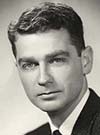 Mark Hatfield. (Governors Photos, OSA)
Mark Hatfield. (Governors Photos, OSA) Meanwhile, many state legislators got into the act as well. Both the California and Washington legislatures formed committees with the goal of purging communists and sympathizers from state universities. The committees conducted hearings, required loyalty oaths, and applied other means of pressure with the help of university governing boards and administrators. The actions of these committees led to turmoil among professors at the University of California and the University of Washington. Oregon avoided the strife on its campuses but very nearly passed a law that would have required public school teachers and state college professors to submit a signed statement saying "whether the applicant is or has been a member of or is or has been affiliated with the Communist Party or any other organization that believes in, advocates or teaches the overthrow of the United States Government or the government of the State of Oregon by force or any unlawful means." The bill also would call on teachers and professors to state if they had "contributed time or money to the support of, or has subscribed to, taught or advocated the principles of such party or organization." Those who had would need to submit a detailed explanation of their participation. Anyone who failed to cooperate could have been fired.
Footnote 2
Only intense and last-minute backroom lobbying by former Governor Sprague averted passage of the bill. Those who would have been affected by it were largely muzzled. Maurine Neuberger, a legislator who had been active in the teachers' union later remembered the oppressive climate of the 1950s, saying "teachers were afraid to speak out...afraid to participate in politics." Professors were prohibited from directly contacting legislators during the session by the State Board of Higher Education. The board, fearful of budget reprisals, remained neutral on the issue. With the affected parties silenced, the measure passed the state Senate by a 25 to 5 vote. It fell to Sprague, as the most outspoken newspaper editor on the issue, to kill the bill in the House. He quickly prowled the State Capitol corridors looking for legislators to lobby, cornering freshman representative Mark Hatfield, one of the co-sponsors of the bill, three times before convincing him to drop his support. Still fearing defeat, Sprague resorted to an uncharacteristic backroom deal with the house leadership to kill the bill by sending it back to committee just before adjournment. Commenting later on his political tactics, Sprague "figured this was a time when 'children of light' might learn something from the 'children of darkness.'"
Footnote 3 High McCarthyism
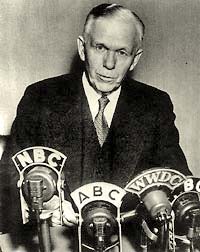 George C. Marshall, instrumental in winning the war and helping Europe recover in the postwar period, had his reputation attacked by Wisconsin Senator McCarthy. (Image courtesy foreignaffairs.org)
George C. Marshall, instrumental in winning the war and helping Europe recover in the postwar period, had his reputation attacked by Wisconsin Senator McCarthy. (Image courtesy foreignaffairs.org) Although many state legislators and members of Congress proved more than willing to place limits on personal liberties in the pursuit of communists, none could match the determination of the Wisconsin Senator Joseph McCarthy. McCarthy grabbed the national spotlight on Feb. 9, 1950 during a speech in which he held up a list that he claimed included over 200 "card-carrying" members of the Communist Party. His timing was perfect to raise the issue to a fever pitch. In the weeks before McCarthy's speech, the Soviet Union tested an atomic bomb, China fell to the communists, Alger Hiss was convicted of perjury in a case related to communist espionage, and a physicist on the Manhattan Project confessed to giving atomic secrets to the Soviet Union.
Over the next four years, McCarthy used his position on a Senate subcommittee to carry on a crusade against communism, leaving decency and broken lives in his wake. His committee worked overtime to examine 653 witnesses during 1953 and early 1954. McCarthy's tactics included floating wild accusations and browbeating witnesses, even attacking the reputations of leaders such as George C. Marshall and Adlai Stevenson. Relying on extensive press and television coverage, whose reporters couldn't resist his sensationalistic tactics, McCarthy portrayed himself as a tough guy. He often used vulgar words to characterize the "vile and scurrilous" objects of his attacks.
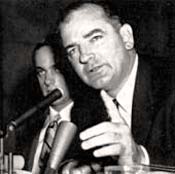 Senator McCarthy wielded great power on the national stage in the early 1950s. Even President Eisenhower, who deplored McCarthy's tactics, felt politically unable to publicly rebuke him.
Senator McCarthy wielded great power on the national stage in the early 1950s. Even President Eisenhower, who deplored McCarthy's tactics, felt politically unable to publicly rebuke him. McCarthy's appearance at an annual picnic sponsored by the Multnomah Republican Club in 1951 threatened to expose divisions within the Oregon Republican Party. Many newspaper editorial writers lashed out at the senator in advance of his visit. Once again, former Governor Sprague, representing the moderate wing of the party from his editor's desk at the Salem
Statesman, led the charge, writing that "because the Statesman regards him as a mendacious demagogue it protests his appearance in Oregon as a guest of an organization identified with the republican party." But undaunted by the negative press about McCarthy, Republican Governor Douglas McKay, along with much of the state Republican Party leadership, attended the picnic. Despite the governor's presence, only a handful of elected officials dared to show up. In the end, the crowd was smaller than expected for a speaker who was regularly in the headlines. Reports also noted a small band of hecklers on hand to greet McCarthy. The picnic was the senator's only appearance in Oregon.
Footnote 4 A Bully Falls
After years of bullying, harassing and failing to produce hard evidence against his targets, the public finally tired of McCarthy's tactics. Two events in 1954 combined to turn public opinion against the senator for good. First, respected television journalist Edward R. Murrow presented a program featuring clips of McCarthy speaking. Among other accusations leveled, the senator said the Democratic Party had been "in charge of twenty years of treason." In another clip he made similar charges against the Roosevelt and Truman administrations. More clips included exchanges in which he berated witnesses, including an Army general. Edited in this way, viewers got their most meaningful look at McCarthy's methods, and they didn't like what they saw.
Footnote 5
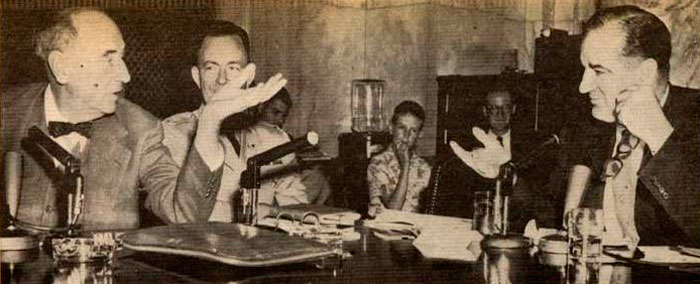 Army Attorney General Joseph Welch (left) confronts Senator McCarthy (right) during the Army-McCarthy Hearings in 1954. The event had a profound effect on public opinion and led to a backlash against McCarthy. He was censured by the Senate later that year and died of liver disease a few years later.
Army Attorney General Joseph Welch (left) confronts Senator McCarthy (right) during the Army-McCarthy Hearings in 1954. The event had a profound effect on public opinion and led to a backlash against McCarthy. He was censured by the Senate later that year and died of liver disease a few years later.
"Have you no sense of decency, sir? At long last, have you left no sense of decency?"
The second telling event began the next month when the Army-McCarthy Hearings were broadcast live to more than 20 million viewers over 36 days. The hearings had been called to look into allegations that McCarthy had tried to bully the Army into not drafting one of his aides. During the course of the hearings, and after one too many reckless accusation by McCarthy, Army Attorney General Joseph Welch solemnly asked: "Have you no sense of decency, sir? At long last, have you left no sense of decency?"
Welch's question spoke for millions of viewers in their homes asking the same thing. His credibility broken, his intimidation no longer effective, McCarthy was censured by the Senate later in 1954. The hunt for communists in America would continue through much of the 1950s but most people were ready to close one of the darker chapters of the country's history.
Footnote 6 Related Document
 "Senate Bill No. 323,"
"Senate Bill No. 323," Oregon Legislative Assembly, 1951. Original Bill Files, Oregon Legislative Assembly Records, OSA.
Notes